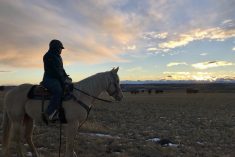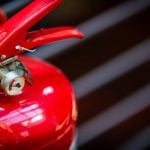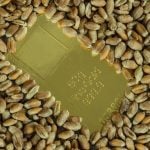The final stage of labour is shedding of placental membranes. The cow continues to have uterine contractions (often accompanied by abdominal straining for a few hours after calving) until the membranes come loose and emerge through the birth canal. The stretched uterus begins shrinking as soon as the calf is delivered, and uterine contractions may continue for several days — though decreasing in frequency and intensity. These contractions aid the shrinking (involution) process and help flush extra fluids and tissue debris from the uterus.
The placenta usually begins working free soon after the calf is born. When the cow gets up, this red mass of tissue is usually hanging from the vulva. It may take a few minutes or a few hours to fall out. Most cows shed their placenta within two to eight hours of calving, but some take much longer and this is called a retained placenta.
Read Also

Reintroducing fire to Saskatchewan pastures
Pastures evolve over time. Woody plants and shrubs, which cattle can’t eat, may encroach on natural grasses. Invasive species, such…
Placenta retention generally has no long-term ill effects, but in some instances may lead to infection. Depending on the type and seriousness of infection, the future fertility of the cow (or even her life) may be in jeopardy, without prompt and appropriate antibiotic treatment.
Factors leading to retained placenta include anything that interferes with normal “unbuttoning” of cotyledons that attach the placenta to the uterine lining, or anything that limits uterine contractions during/after calving. Contractions distort the shape of the attachment areas and help cause physical separation. Uterine inertia (insufficient contractions during labour and after delivery) may lead to retained placenta. A cow that loses her calf at birth or doesn’t have a calf nursing soon after birth may be slower to clean because action of suckling stimulates release of oxytocin in the cow and triggers uterine contractions as well as milk let-down. If a cow does not shed her placenta within 36 hours following birth, there’s a good chance she won’t shed it for seven to 10 days, since uterine contractions have ceased. It then takes the shrinking of the uterus and disintegration of the attachments for the tissues to come loose.
Dr. James England (University of Idaho Caine Center) says one of the main causes of retained placenta is inadequate nutrition, especially the lack of certain trace minerals. “There are good indications that trace minerals, particularly selenium, have a big influence on the health of the reproductive tract, and deficiencies can lead to retained placentas and uterine infections. What looks like a normal birth may end up with a retained placenta,” he explains.
Dr. Robert Callan, professor of livestock medicine and surgery at Colorado State University, says the No. 1 reason for retained placentas where he grew up in Oregon was selenium deficiency.
“You’ll also see retained placenta due to dystocia. This can be prevented or greatly reduced by using calving ease bulls on heifers. Body condition of cows at calving can also be a factor in retained placenta, and may also lead to dystocia — since a cow that’s too thin or too fat may have more trouble calving,” says Callan.
“Retained placenta in some of the herds I’ve dealt with occurs more commonly in first calf heifers,” says England. “This is often due to inadequate nutrition. The young cow is trying to grow, mature a fast-growing fetus, and get ready to produce milk. She’s often under nutritional stress, especially if she’s with the main herd and can’t compete with older cows for feed,” says England.
“Another thing that can lead to retained placenta is if a calf is pulled and there isn’t good detachment of the placenta. It takes awhile for it to come loose,” he says. Some cows may take as long as 10 or 12 days to shed the rotting membranes.
“Cows that have vaginal/rectal prolapse before calving may retain the placenta after calving. Usually it’s wise to cull those cows, because once they have a pre-calving prolapse they tend to do it every year,” says England. “Some family lines have more vaginal prolapses and possibly more retained placentas. A cow too thin or too fat may be more prone to retain the placenta than a cow in normal body condition. A cow that’s too fat also has more propensity to prolapse before calving,” he says.
Cows that abort after the first half of gestation or give birth prematurely, or have twins will often retain the placenta. Twins tend to come a little early, and this may be one reason twin births lead to retained placenta.
“In these instances the placenta doesn’t detach very well. An abortion, for instance, is brought about by the fetus dying, and instead of a change in hormones at the right time, there’s no signal to stimulate the membranes to begin detaching,” says England. A full-term fetus triggers its readiness for
birth by sending hormonal signals to the cow, which stimulate her to begin labour and uterine contractions — preparing the cotyledons to “unbutton” so the placenta can come loose and be shed after the birth.
For proper detachment to occur, the attachment areas must be mature and ready to loosen. This maturation process occurs during the final stages of pregnancy and depends on rising levels of estrogen in the cow. It is usually complete about two to five days before calving. If anything interferes with proper maturation, such as premature birth or death of the fetus, the placenta may be retained. If the fetus is dead it doesn’t send hormonal signals; the placenta doesn’t detach properly and is retained for several days until the tissues deteriorate and come loose.
Abortions before the fifth month of gestation often have very little external signs (you may not notice the cow aborted) and are seldom followed by retained placenta. But abortions after the fifth month usually result in retained placenta. Abortion may occur in the last trimester in mountain regions if cows eat Ponderosa pine needles, and these abortions are almost always followed by retained placenta. In these instances it may take two or three weeks for the cow to clean and she may need antibiotics.
“Most abortions today are viral in nature (such as BVD or IBR infections), so in these instances the uterus is not full of bacteria unless the fetus has died and the cervix is open awhile in a late-term abortion, allowing pathogens to enter. In most abortions the placenta is just not ready to detach and takes awhile. Some of these cows may need a flush to help the placenta come loose,” explains England.
In most cases, however, retained placenta is merely an aggravation and not a problem. “In my experience, probably 90 per cent of these go ahead and clean within four to eight days, without having anything done to treat them,” he says.
According to Dr. Dick Fredrickson, a veterinarian at Grandview, Idaho, there are many factors that can lead to retained placenta, but occasionally it’s simply a mechanical problem. “The placenta isn’t actually still attached — it has come completely unbuttoned — but gets hung up on a caruncle (the maternal site of attachment for the cotyledon),” he explains.
Treatment
In earlier times, stockmen felt they needed to treat every cow that retained her placenta and that these membranes should be removed. We now know that trying to remove the placenta may do more harm than good. “Cows with retained placenta mainly just need time for the membranes to rot away from the attachments and come loose,” says Callan. The placenta will eventually come loose and the cow will be fine, unless she develops an infection that invades the uterine tissue (metritis) or the bloodstream (septicemia).
“There are many discussions regarding whether or not to treat if a cow simply retains her placenta (with no evidence of infection),” says England. The general consensus today is to not try to manually remove it. It will eventually come free on its own, with less risk of tearing and leaving a piece behind in the uterus. If the placental membranes are torn away, the hookups on the uterine lining are opened for easy access by bacteria.
“People used to try to remove the
placenta, especially in dairy cows. Every cow was flushed and we put an antibiotic bolus in the uterus, but now we don’t do that. Treatment is determined on a case-by-case basis. Standard treatment is a Betadine-solution flush, simply putting the fluid into the uterus and flushing it out,” he says.
Injections of oxytocin are sometimes given, in an attempt to stimulate more uterine contractions — which would help the tissues come loose — but this is only helpful during the first eight hours after calving. “After six to eight hours there’s no beneficial effect from oxytocin because of hormonal changes in the uterus,” says Fredrickson. “After that period of time, Lutalyse is probably the drug of choice,” he explains. This would work better than oxytocin if the cow has retained the placenta for a day or more.
“If the placenta has been hanging out longer than a day or so and I can get the cow in, I cut it off midway so it’s not dragging on the ground,” says England. If the membranes are stepped on they may be forcibly torn away. Dragging on the ground through mud and manure they also serve as a “wick” for more pathogens and contamination to get into the uterus.
“We don’t recommend reaching into the uterus to manually remove the membranes,” says Callan. “Studies have shown this causes damage to the uterine wall and compromises future fertility. You can, however, grab hold of the external portion that’s hanging out and put gentle traction on it. If it comes out without tearing, this is fine. Just don’t pull very hard. If you feel it start to tear, stop. Pull a little bit again the next day.”
Another thing he often does is take hold of the membranes while wearing a rectal palpation sleeve, and start pulling gently to see how much comes out. “If it’s stuck, I stop, and while still holding the placenta I’ll invert the rectal sleeve over it. Now the portion of the placenta that’s outside the cow is inside the plastic sleeve and not dragging around on the ground,” says Callan. He ties a knot in it and this shortens it up so it stays cleaner and won’t be stepped on and torn. This also keeps a little weight on the placenta, for gravity to help ease it on out.
“In the dairy industry many people flush the uterus with Betadine solution or some other antiseptic if the cow retains her placenta, but this is highly controversial,” says England. “Putting fluid into the uterus helps loosen things up, or at least that’s what we think. Normally I haven’t had to do that in beef cows. If you give them a few days to shed it, everything seems to clean up and the uterus remains healthy. If cows are out moving about, and not having other problems concurrently (such as a metritis that turns into an infection), they go ahead and shed the placenta,” says England. A cow with retained placenta may shed it faster if she can be moving around than if she is confined with very little exercise.
“The main treatment for most cases is just tincture of time, and monitoring the cow to make sure she doesn’t have a fever that would indicate infection,” he says. If she becomes dull or goes off feed, she’ll need antibiotic treatment. If she hasn’t cleaned within about six days it might be good to check her, to make sure she doesn’t have an infection. By then however, the membranes are usually starting to work on out, and you just need to monitor and make sure they are shed without further complications.
If the cow does not develop serious infection she’ll eventually clear the temporary inflammation and local infection and have normal fertility afterward, especially if she is not bred again until at least 60 days after calving — to give the reproductive tract a chance to get back to normal again.
Callan says the main thing is to monitor the cow until she cleans, to make sure she is still eating and feeling good. “If you think she might be sick, check her temperature. If it’s higher than 103F you should treat her with an antibiotic. Choices include penicillin, oxytetracycline or ceftiofur (Excenel). These are all fairly effective for treating septic retrained placenta in which metritis has led to septicemia,” says Callan.
If a rancher has more than an occasional case of retained placenta, England recommends examining the mineral status of the herd. “It would be worthwhile to do blood test trace mineral analyses and see what the deficiencies might be. A blood sample isn’t as good as a liver biopsy, but it does tell you what the mineral status is at that point in time, and gives you a place to start. If things are out of whack it might pay to do some liver biopsies,” says England. If there’s a problem, he recommends working with a cattle nutritionist to develop a trace mineral program to correct the deficiency.















